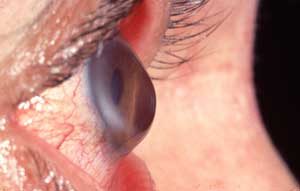 Keratoconus (KC) is a condition of the eye meaning conical cornea. It is a rare condition. Numbers affected vary between 1 in 3,000 and 1 in 10,000 depending on where they live. It usually affects both eyes, although one eye is normally affected before the other.
Keratoconus (KC) is a condition of the eye meaning conical cornea. It is a rare condition. Numbers affected vary between 1 in 3,000 and 1 in 10,000 depending on where they live. It usually affects both eyes, although one eye is normally affected before the other.
KERATOCONUS literally means “conical or cone-shaped cornea” and it is a condition that affects vision.
The cornea is the major focussing surface of the eye. In keratoconus, the cornea becomes stretched and thin near its centre, and the thinned part of the cornea bulges making the vision more shortsighted and irregular. As a result the vision is distorted. The stretching of the cornea tends to progress but the rate varies. Sometimes one eye may be badly affected while the other eye may show very little sign of the condition.
The cause of keratoconus is unknown. However, it may be associated with allergy or possibly have a genetic component. Keratoconus rarely appears in an individual until puberty or beyond. Although no one can be sure how far keratoconus will develop in an individual, the condition does not cause blindness. With the current treatment available most people should be able to lead a normal lifestyle as a result of the condition. However, good vision may be difficult to maintain at times as the condition progresses and contact lens tolerance varies. The first line of treatment is usually with rigid contact lenses although some people with early keratoconus may be able to wear spectacles or soft contact lenses.
There is a small risk of infection when wearing contact lenses and the risk becomes much greater if the lenses are not kept clean, so it is important to strictly follow the hygiene instructions given when the lenses are fitted. Contact lenses do not, unfortunately, slow down the rate of progression of the cone, but they do give good vision during that period which could not otherwise be achieved. Drops, ointment, dietary changes and eye exercises also don’t help but the condition does eventually stabilise, although it may take many years before that happens.
In about 10% to 20% of keratoconus patients the cornea may become extremely steep, thin and irregular or the vision cannot be improved sufficiently with contact lenses. The cornea may then need to be replaced surgically with a corneal transplant or graft. Visual recovery after a transplant takes a long time – sometimes as long as eighteen months – to settle down and there is a strong possibility that the eye will still need to be fitted with a contact lens afterwards in order to see properly. Surgery is therefore not a shortcut to perfect vision nor a way of avoiding contact lens wear.
There is also a risk of the transplant rejecting afterwards although over 90% of corneal transplants that are done for keratoconus are successful. For patients of Moorfields Eye Hospital: if at any time your eye is uncomfortable or you think something is not right, do discuss it with your contact lens practitioner when you come to the clinic. If necessary make an earlier appointment to attend the hospital or in an emergency the Accident and Emergency (Casualty) Department is open 24 hours. Patients of the Contact Lens Service can be seen in the department from 9am to 5pm Monday to Friday.
